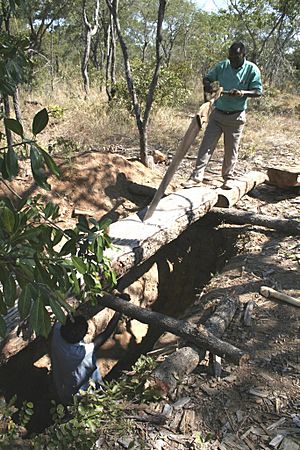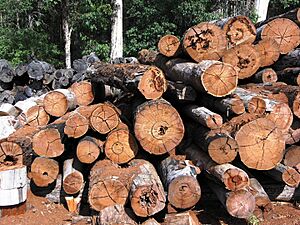Saw pit facts for kids
A saw pit is a special hole or ditch in the ground. People used it to cut large tree trunks into planks or boards. Two people worked together: one stood above the log, and the other stood in the pit below. They used a very long saw with two handles. Saw pits were important for making wood for buildings, fences, and especially for building ships. Many towns and large estates had their own saw pits.
Contents
How Saw Pits Worked
A sawyer is a person who cuts wood for a living. Long ago, sawyers were very important in communities because many things were made from wood. In England, the person standing in the pit was called the 'bottom sawyer'. The person standing on top of the log was called the 'top sawyer'.
Together, the two sawyers would pull a special two-handled saw through the log. This saw was called a 'whipsaw'. If the cut, called a 'kerf', started to close, the saw could get stuck. Sawyers would put small wooden wedges into the cut to keep it open and make sawing easier. The whipsaw was designed to cut in both directions. Sawdust would build up and had to be scooped out with a bucket.
The top sawyer had a very important job. They had to balance on the log and guide the saw to make sure the planks were straight and even. They often followed a chalk line drawn on the log. Sawing was hard work and needed strong people with lots of energy. The top sawyer needed to be extra strong because they pulled the saw upwards against gravity.
Saw pits were vital for shipbuilding. Large planks were needed to build all kinds of ships. The logs were placed over the pit and held steady with special clamps. The junior sawyer worked in the pit, which could be wet and full of sawdust. Some people think the phrases 'top dog' and 'underdog' came from saw pit work. The 'top dog' was the boss, and the 'underdog' was the one doing the harder work below.
A saw pit could usually produce about 12 boards a day with two people. Later, water-powered sawmills could make up to 200 boards a day! Sometimes, one person could work a saw pit alone by adding a heavy stone to one end of the saw to help pull it down.
History of Saw Pits
People have been cutting wood for a very long time. An early water-powered sawmill was used by the Romans in a place called Hierapolis. Sawmills might have also been used in the medieval period. They became more common in Europe in the 1500s.
The 'modern' sawmill was greatly improved by a Dutchman named Cornelis Corneliszoon around 1593. He figured out how to use a windmill to power a saw. The turning motion of the windmill was changed into an up-and-down motion for the saw blade.
When sawmills became more common, some sawyers who worked in saw pits worried about losing their jobs. They even burned down some early sawmills in England. However, sawmills were much more efficient and less back-breaking than saw pits. Because of this, saw pits slowly stopped being used in the United Kingdom during the Industrial Revolution. Old maps from the 1860s sometimes show where saw pits used to be. By the 1900s, very few were still in use.
Saw Pits in Royal Dockyards
Saw pits were brought into Britain's Royal Dockyards in the mid-1700s. These were places where ships for the navy were built. Before saw pits, workers used trestles (wooden frames) to hold logs and a different type of saw.
In the Royal Dockyards, the top sawyer was called the 'Topman'. He made sure the cut was straight. The 'Underman' was in the pit and pushed the saw up. Logs were held tightly with 'G' shaped clamps called 'dogs'. The pits were often lined with elm wood because it could handle damp conditions. Sawyers were paid based on how much wood they cut and how hard the wood was to saw. Oak wood paid the most.
Saw Pits Around the World
Australia
Saw pits provided most of the cut timber in Australia during the 1800s. Convicts were often made to work in saw pits as a punishment in places like Tasmania.
Saw pits were also part of important early events in Australian history. In 1788, Captain William Bligh (from the famous Mutiny on the Bounty) used a saw pit to repair his ship. Also in 1788, when the first British fleet arrived to settle Sydney, saw pits were quickly dug to produce wood for building.
New Zealand
Saw pits were very important for early European logging in New Zealand. Even after water-powered sawmills arrived in the 1840s and steam-powered ones in 1865, saw pits were still used in hard-to-reach places until the early 1900s.
A sawyer in New Zealand could earn a lot of money. For example, in the 1840s, a sawyer could make 80 pounds in five months. This was more than double the average wage at the time.
Interesting Facts About Saw Pits
The saw pit at Llanaeron Home Farm is special because it's inside a building with an open front.
Sometimes, you find 'Q-pits' near saw pits. Q-pits were used to make 'White coal', which is a type of charcoal.
Famous writer William Shakespeare mentioned saw pits in one of his plays, The Merry Wives of Windsor. Also, in Daniel Defoe's book, the character Robinson Crusoe complains about how hard it is to cut wood without a saw pit.
There's a story about Philip Wharton, who became Lord Wharton in 1625 when he was 12. During a battle in 1642, he supposedly ran away and hid in a saw pit. This earned him the nickname Philip 'Sawpit' Wharton!
Some towns in the United States were once called Saw Pit. For example, the settlement of Saw Pit in New York eventually grew and changed its name to Port Chester in 1868. There is still a town called Sawpit, Colorado in the USA today.
Places Where Old Saw Pits Can Be Found
- Brede High Farm, East Sussex, England. More than 30 old saw pits have been found here.
- Cotehele, Cornwall, England. This saw pit is kept in working order by the National Trust.
- Elvet, County Durham, England.
- Haltwhistle, Northumberland, England. A saw pit is located next to the Haltwhistle burn.
- Haswell, County Durham, England.
- Kibblesworth, County Durham, England.
- Little Lumley, County Durham, England.
- Quarrington, County Durham, England. A saw pit near Quarrington Hall.
- Marble Head, Restronguet Point, near Falmouth, Cornwall, England. A trench here might have been a saw pit.
- Singleton, Chichester, West Sussex, England. There's a covered saw pit at the Weald and Downland Museum.
- Broomhill, Scotland.
- Cadham, Scotland.
- Charlie's Sike, Scotland.
- Kennox estate, Scotland.
- Kirkton Muir, Scotland.
- Nettlehirst near Barrmill, Scotland.
- Pennyseorach, Scotland.
- Strathallan Wood, Scotland.
- Woolforddyke, Scotland.
Images for kids








